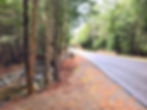Planning your fall fly fishing trip
- The Trout Bandit
- Jul 5
- 3 min read

Some of my fondest memories of fly fishing for trout tend to involve a brilliant and fresh autumn day. There is something about the freshness of the air and colors of the trees that makes a day out fishing seem even more exceptional. When planning your special excursion for this autumn, you may consider a trip to the northeast of the US, preferably before the fall foliage attracts the throngs of leaf peepers.
Brook trout in Acadia National Park
Most of the information on trout fishing on Mount Desert Island and Acadia National Park features lake fishing for stocked fish. A guide produced by the Department of Inland Fisheries and Wildlife is very extensive, but is exclusively focused on lake fishing, which generally requires watercraft access and/or is not appropriate for fly casting from shore. However, an intensive search of the web will produce a few nuggets of intel as it relates to small streams that hold native brook trout.

In researching brook trout fishing in Acadia, I found several bloggers that recommended Hunters Brook, particularly the stretch that follows the Hunters Brook Trail. The trailhead is accessed via a layby on the south end of the Park Loop Road as it passes under Route 3. Ambling along this stretch of Hunters Brook is relatively easy and you may find the brookies very attentive to dries, particularly a neversink caddis fly.

Another option on Hunters Brook is to access its outlet to the ocean at Hunters Beach Cove. The Hunters Beach Trailhead and parking is just off Cooksey Drive near Route 3. The trail meets Hunters Creek about halfway to the Cove, so it is best to begin where it ends at the rocky beach and fish your way upstream.
A further option for seeking out brook trout is on Stanley Brook at Seal Harbor. Parking is available at a reasonably sized municipal lot fronting the beach. Then follow Stanley Brook Road and find opportunities to bushwack through the dense foliage to reach the stream. There are also various spots where the creek passes under the road making access to some nice pools and riffles a bit easier. But expect this option to be a bit more of an adventure than along Hunters Brook.

The brook trout will be on the smaller size (2-4”) but colorful and feisty. The best choice for gear would be a 7ft, 3wt rod equipped with a 6ft mountain stream leader and fishing caddis fly patterns. The streams in the park are closed to fishing after September 30, but lakes and ponds remain open to fishing year-round.
Brook trout in White Mountain National Forest
There is some outstanding brook trout fishing within a short drive of North Conway, New Hampshire in the White Mountains region. A short drive to the north of town at the end of Town Hall Road near Mountain Pond is Slippery Brook. A car park is situated at the trailhead and it is an easy amble along the trail that parallels Slippery Brook, which reminded me of the mountain streams I fish in Shenandoah National Park, with lovely riffles and pocket water. This is very exciting brook trout water that is easily accessible.

Even more prolific is a water near the Kancamagus Highway, a short drive to the west of North Conway, at Sabbaday Falls. After parking in the lot (which requires a $5 fee that is waived if you have a National Parks pass) the first ¼ mile of the trail leads to a spectacular waterfall, and the trail continues along after the falls. This stream offers some of the best brook trout fishing I have ever encountered and again was similar in nature to the mountain streams I fish in Shenandoah National Park.

Expect the brookies to be smaller, in the 3-4” range, but they will be feisty and fun to catch. Gear up with a shorter, lightweight fly rod (6-7 feet, 3wt) with a 6ft mountain leader and various parachute dry fly patterns.
Tight lines and safe travels!
